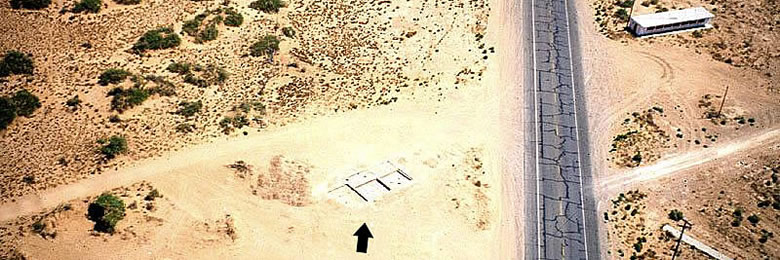
Looking west across site area toward
the Franklin Mountains in the distance. With only 8
inches of annual precipitation, the site environment
today supports semi-arid desert shrubs with little grass,
lots of mesquite, creosote bush in gravelly areas, and
some narrow-leaf yucca. Pueblos tend to be concentrated
near mountains where runoff could be used to water crops
and surface water would have been available for drinking.
The mountains and foothills supplied timbers for houses,
a variety of plant and animal foods, and raw materials
for chipped and ground stone artifacts.
|
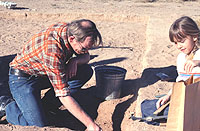
Sgt. Richard Dillard and his daughter
working in Room 2. The drill sergeant at Ft. Bliss had
noticed the work at the pueblo while passing on Highway
54. Like many others he stopped, visited, asked questions,
and returned to help with work at the site. The Dillards
are one of many families who took part in the work.
|
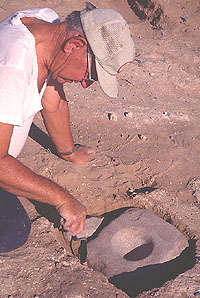
Hal Siros uncovers a finely shaped
mortar and pestle set cached in pit of Room 15, one
of the pithouses found beneath the pueblo.
|
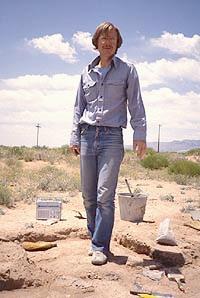
Site director Tom O'Laughlin at Firecracker Pueblo in
the mid 1980s. For 10 years O'Laughlin worked with members
of the El Paso Archaeological Society, university students,
and many other volunteers, including members of the Texas
Archeological Society to excavate the site. Photo by David
Guiffe. |
|
Firecracker Pueblo appeared to be a small and
unremarkable pueblo when it was first recorded in 1975. Next
to Highway 54 in northeast El Paso, Texas, 8 km south of the
Texas-New Mexico border, the leveling of sand dunes had revealed
the adobe walls of what was thought to be a pueblo of some
6 to 10 rooms. Between 1975 and 1979, additional grading of
the site area exposed more walls, dark soils, and a variety
of ceramic and stone artifacts. Temporary fireworks stands
placed on the site during this period gave the site its name.
Vandals began digging in several rooms, and the area became
part of an industrial park. Fearing greater damage or loss
of the site, formal excavations to document the site were
started in the summer of 1980. At the time, we had no idea—or
desire—that the Firecracker investigations would last
for ten years.
Volunteers led by archeologist Thomas C. O'Laughlin
provided the direction and work force for the project, and
literally hundreds participated in the excavation on weekends,
holidays, and, on occasion, for one or two weeks in the summer.
The youngest volunteer was 4; the oldest over 80. Many were
members of the El Paso Archaeological Society (EPAS), but
the location of the site next to a major highway lured numerous
passersby into lending assistance (see Public
Archeology). Television and newspaper coverage also stimulated
interest. Professors in a variety of disciplines from the
University of Texas at El Paso spent time at the site, as
did their students (sometimes for credit). In 1986, the Texas
Archeological Society held its field school at the site and
over 200 people participated in the eight-day event (see "Just
Barely in Texas").
The field investigations of Firecracker Pueblo
lasted 10 years in part because of the intermittent schedule
of an all-volunteer operation, but mainly because the site
proved larger and more complex than we first expected. As
we learned more about it, we saw opportunities to address
new questions and altered the strategy accordingly. Prior
to the investigation of this site, there had been no systematic
excavation of areas lying outside of pueblo rooms. In the
Jornada region, pueblo sites had been treated as if the pueblos
themselves were all that was important to study. At Firecracker,
we wanted to know what lay beyond the adobe walls—what
did the whole site look like? Therefore, we conducted systematic
and extensive excavations of extramural (outside-the-walls)
areas and found numerous and varied features, superimposed
structures, and considerable trash. Some findings were expected;
others were intriguing. Perhaps the most important discovery
was that of 17 pithouses from one or several shortterm occupations
immediately prior to the construction of the pueblo.
Site Map with Room Numbers
Most of the site maps used in this exhibit have
been simplified or altered for emphasis. This map shows the
room numbers assigned to both pueblo and pithouse rooms.
Sliding into Archeology
Tom O'Laughlin, the archeologist who led the
Firecracker investigations and the primary author of this
exhibit, became interested in archeology in a most unusual
way. As a child, he lived at White Sands Missile Range where
his father served in the Army. He remembers being intrigued
with scattered pieces of pottery and other strange objects
he found in his backyard. These, he was told, were very old
Indian artifacts. Then one day while playing baseball on a
sandy lot behind the school, a teammate slid into third base
a bit too enthusiastically. When the dust settled, bones were
visible in the freshly ploughed sand—human bones. O'Laughlin
returned to the sandy lot the next day and watched with fascination
as a tall lanky man carefully exposed what remained of the
burial.
As it turned out, the man was archeologist Larry
Hammack, then on loan to the Army from the Laboratory of Anthropology
at the Museum of New Mexico. He was there because the Commanding
General of White Sands was keenly interested in archeology.
With the Commander's encouragement, Hammack and off-duty military
personnel excavated a small El Paso phase pueblo on the base.
O'Laughlin visited the dig every chance he got, asking questions
and learning about what was being found. Others took him on
field trips and introduced him to rock art. He was hooked.
O'Laughlin joined the El Paso Archaeological Society in 1960
and has been a member ever since.
After his family moved to Las Cruces, he started
archeological projects on his own, recording sites in the
area. While still in high school he began giving presentations
and writing papers, efforts that earned him an award from
the New Mexico Archaeological Society. The summer he graduated
from high school he attended the University of New Mexico
field school at Taos and became acquainted with professional
archeologists who became his mentors and life-long friends.
His path was set.
In college he pursued biology and anthropology,
earning several biology degrees from New Mexico State University
and a Masters in Anthropology from the University of New Mexico.
Throughout he worked on archeological projects every chance
he got, first as a volunteer and then as a paid archeologist.
Some of his early projects included Fremont sites in Utah
through Jesse Jennings, the Anasazi Origins Project directed
by Cynthia Irwin-Williams in central New Mexico, and excavations
at Fort Fillmore directed by John Wilson of the Laboratory
of Anthropology of the Museum of New Mexico.
Today O'Laughlin is the Assistant Director of
the Albuquerque Museum. He has been long associated with natural
history and history museums. While running the Firecracker
excavations, he served as chief curator at the El Paso Centennial
Museum and Director of the Wilderness Park Museum. He has
also done contract archeology, taught at UT El Paso, and co-directed
the Jornada Anthropological Research Association.
Throughout his career O'Laughlin has maintained
a close relationship with avocational archeologists. He is
a longtime member of not only the El Paso Archaeological Society
but also TAS, the New Mexico Archaeological Society, and the
Arizona Archaeological and Historical Society. Presently,
he is a Trustee for the New Mexico Archaeological Society.
Firecracker Pueblo lies at the heart of O'Laughlin's
geographical area of interest—central to southern New
Mexico and west Texas, with extensions into Mexico. Although
a specialist in the pueblo period, he has worked on many other
kinds of sites. For example, he worked with J. Charles Kelley
at Alta Vista in Zacatecas, Mexico, a major ceremonial center
of the Chalchihuites Culture about A.D. 500. Currently (2001),
he is working with Mike Adler and Michael Bletzer of Southern
Methodist University on the investigation of Piro pueblos
near Socorro, New Mexico.
|
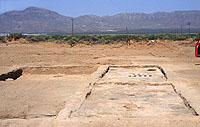
Looking west across the first four
rooms of pueblo to be excavated.
Click images to enlarge
|

Members of the El Paso Archaeological
Society admiring a job well done at the end of the day.
In the foreground is a nice pueblo room.
|
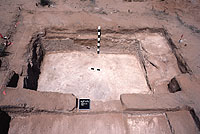
Room 22, excavated by Rob Vantil's
TAS crew, is a deep pithouse thought to have been used
for storage because of the absence of the usual floor
features. Trash had been dumped in this room by the
later occupants of the pueblo.
|
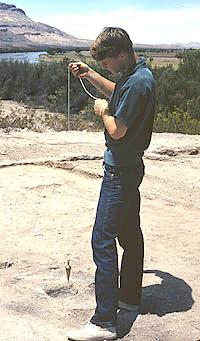
Tom O'Laughlin helps map Robledo
Mountain Pueblo near Las Cruces, New Mexico, while still
a teenager. His precocious archeological work as a high
school student earned him an award from the New Mexico
Archaeological Society and set his career path. Photo
by Dave John.
|
|
